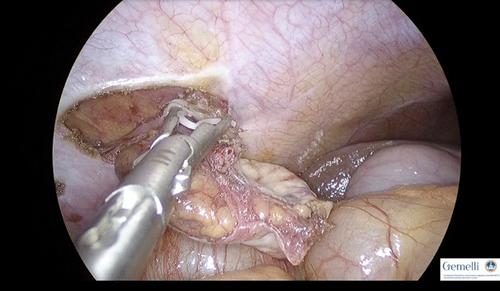Annals of Surgical Oncology ( IF 3.4 ) Pub Date : 2022-05-24 , DOI: 10.1245/s10434-022-11870-0 Nicolò Bizzarri 1 , Matteo Loverro 1 , Martina A Angeles 2 , Luigi Pedone Anchora 1 , Anna Fagotti 1, 3 , Francesco Fanfani 1, 3 , Gabriella Ferrandina 1, 3 , Giovanni Scambia 1, 3 , Denis Querleu 1

|
Preservation of ovarian function is important for the physical and psychosexual well-being of young patients with cancer. Patients with pelvic malignancies such as cervical or rectal cancer planned for radiotherapy may benefit from ovarian transposition with the aim of moving the ovaries outside the radiation field.1 Different surgical techniques have been reported previously.2,3 With the present video, we aim to standardize the surgical technique of laparoscopic ovarian transposition in ten steps. We present the case of a 30-year-old nulliparous woman diagnosed with grade 3 squamous cell cervical carcinoma having a largest tumor diameter of 41 mm on magnetic resonance imaging (MRI) scan. The tumor was staged as FIGO 2018 stage IIIC1r with a common iliac lymphadenopathy reported on both MRI and positron emission tomography (PET)/computed tomography (CT) scan. The multidisciplinary team recommended exclusive chemoradiation extended to paraaortic area. The patient underwent laparoscopic bilateral salpingectomy and bilateral ovarian transposition with extraperitonealization of the infundibulopelvic ligament. The procedure was divided into the following ten steps: division of uteroovarian ligament, incision of lateral pelvic peritoneum, identification of ureter, incision of medial pelvic peritoneum, skeletonization of the infundibulopelvic ligament, retroperitoneal tunnel in paracolic gutter, creating the window (as high as possible), mobilization of the ovary without torsion, intraperitonealization of the ovary, and fix ovary with clips (Fig. 1). Surgical time was 30 min, with minimal estimated blood loss. No intra- or postoperative complication was recorded. The patient started radiotherapy 14 days after the procedure. In conclusion, we showed that laparoscopic ovarian transposition in cervical cancer before radiotherapy can be standardized in ten steps with encouraging perioperative results, making it an easily reproducible procedure. Ovarian function is reported to be preserved in 62–65% of cases undergoing ovarian transposition and radiation therapy.4,5
中文翻译:

腹腔镜卵巢转位联合漏斗盆韧带腹膜外十步治疗宫颈癌
保持卵巢功能对年轻癌症患者的身心健康很重要。计划接受放射治疗的盆腔恶性肿瘤(如宫颈癌或直肠癌)患者可能会受益于卵巢转位,目的是将卵巢移出放射野。1以前曾报道过不同的手术技术。2,3通过本视频,我们旨在通过十个步骤规范腹腔镜卵巢转位的手术技术。我们介绍了一名 30 岁未生育女性的病例,其在磁共振成像 (MRI) 扫描中被诊断为 3 级宫颈鳞状细胞癌,最大肿瘤直径为 41 毫米。该肿瘤被分期为FIGO 2018 IIIC1r期,MRI和正电子发射断层扫描(PET)/计算机断层扫描(CT)扫描均报告有常见的髂淋巴结肿大。多学科团队建议将独家放化疗扩展到主动脉旁区域。患者接受了腹腔镜双侧输卵管切除术和双侧卵巢转位术以及漏斗盆韧带腹膜外化术。该过程分为以下十个步骤:子宫卵巢韧带的分裂,切开外侧盆腔腹膜,识别输尿管,切开内侧盆腔腹膜,骨盆漏斗韧带,结肠旁沟腹膜后隧道,创建窗口(尽可能高),无扭转动员卵巢,卵巢腹膜内化,并用夹子固定卵巢(图 1)。手术时间为 30 分钟,估计失血量最少。没有记录到术中或术后并发症。患者在手术后 14 天开始放射治疗。总之,我们表明,宫颈癌放疗前腹腔镜卵巢转位术可以通过十个步骤标准化,围手术期结果令人鼓舞,使其成为一种易于重复的手术。4,5
















































 京公网安备 11010802027423号
京公网安备 11010802027423号